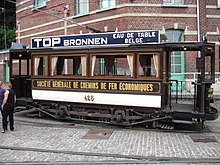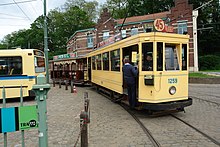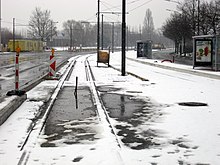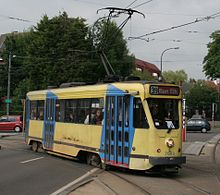Brussels tram
| Brussels tram | |
|---|---|
| Brussels tram 2009 | |
| Basic information | |
| Country | Belgium |
| city | Brussels |
| opening | May 1, 1869 |
| operator | STIB / MIVB |
| Infrastructure | |
| Route length | 138 km |
| Gauge | 1435 mm ( standard gauge ) |
| Power system | 600 volt DC overhead line |
| business | |
| Lines | 18th |
| Line length | 215 km |
| vehicles | PCC car , Tram 2000, Flexity Outlook |
| Top speed | 70 km / h |
| statistics | |
| Passengers | 81.2 million per year (2010) |
| Line network from October 1st, 2018 | |
The Brussels tram is a tram network that connects the Belgian capital Brussels and the surrounding area and is operated by STIB / MIVB . Although the once very extensive network has shrunk significantly in the last decades of the 20th century due to the switch to buses and the construction of the subway , Brussels still has the largest tram network in Belgium with a route length of around 150 kilometers and 18 lines. which partly also runs in tunnels, as " Premetro ".
History up to World War II
The first horse-drawn tram in Belgium ran in Brussels in 1869 on the short distance from Porte de Namur to Bois de la Cambre . In 1877 the first steam tram ran in Brussels, but the steam engine was not powerful enough for the Brussels hills and could barely pull a wagon, so the attempts had to be stopped again. The company Tramways Bruxellois experimented simultaneously with one in Tubize built locomotive, but even this was too weak for the Brussels topography . In 1887 railcars with accumulators were tested. These cars operated with a certain amount of stored electrical energy. However, their use was not satisfactory as there were frequent failures and their range was very limited. The overhead line operation with pantographs as in Liège was also introduced in Brussels and so in 1894 the first electric tram line from Stefanieplatz to Uccle / Ukkel was built . Several companies expanded their tram lines by the turn of the century. The most important companies were:
- TB : Les Tramways Bruxellois, founded in 1875
- CFE : Les Chemins de Fer Economiques, founded in 1889
There were also smaller companies:
- Tramways de Bruxelles à Evere et Extensions, founded in 1883
- Chemin de Fer à Voie Etroite de Bruxelles à Ixelles-Boondael, founded in 1884
The last two companies mentioned operated meter gauge networks and began using steam instead of horse-drawn trams. The small railways set up urban lines in Brussels on their regional rail network. Later, after the merger of CFE and TB, there were only lines of TB and SNCV / NMVB in Brussels . In 1899 the TB received a concession for 45 years on the condition that the entire line network would be electrified. The TB met this requirement in the following years. Up until the First World War , there was great investment in heavier rails and more powerful engines in the railcars. On January 1, 1928, the networks of the TB and the CFE were merged. The CFE were known for their chocolate trams as they chose a dark brown paint for their cars. The CFE staff also wore brown uniforms. In 1928 the lines of the CFE got line numbers according to the system of the TB. In 1935 the length of the Brussels tram network was 240 kilometers, making it one of the largest networks in Europe. Almost 70 lines were operated, with many direct connections between the various city districts. The famous 5000 series multiple units were put into operation for the 1935 World's Fair . These were the first cars with two bogies in Brussels.
Line network in 1935
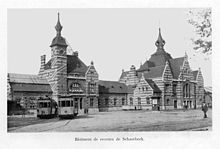
At the time of the 1935 World's Fair, the following tram lines operated by the company Les Tramways Bruxellois SA . The stock exchange was the central hub of the network. The network was very dense, as there were at least two lines on each route in the city center, and eleven on Maurice-Lemonnier-Allee. The (old) place names follow the spelling of the time, here in the Flemish name:
- 2: Verboeckhoven Plaats - Schaerbeekse P. - Park - 4 Arms - Louisa Pl - Louise Laan - Bosch
- 3: Schaerbeek stat. - Verboeckhv Pl - Schaerbeekse P. - Park - Naamse Poort - Louisa Pl - Louise Laan - Bosch
- 4: Beurs - 4 arms - Louisa Pl - Louise Laan - Bosch
- 5: Beurs - Kapel - Halle Poort - Barreel - Plaats van Meenen
- 6: Beurs - 4 arms - Louisa Pl - Vanderkindere - Wolvend. - Carsoel - Ukkel (Fort Jaco)
- 7: Berchem - Basiliek - Simonis - Schaerbeekse P. - Kunst-Wet - Naamse Poort - Louisa Pl - Barreel - Hoogte punt 100
- 8: Plaats E. Bockstael - Liedts - Schaerbeekse P. - Park - 4 Arms - Louisa Pl - Vanderkindere - Av. Longchamp L.
- 9: Gasthuis Brugmann - Jette - Simonis - IJzerplein - Begijnhof plaats - Van Artevelde straat - Anderlecht Poort - Halle Poort - Barreel - Ukkel Calevoet
- 10: Berchem - Basiliek - Simonis - Schaerbeekse P. - Kunst-Wet - Naamse Poort - Louisa Pl - Janson Pl - Vanderkindere - Wolvend. - Carsoel - Ukkel (Fort Jaco)
- 11: Jette - Plaats E. Bockstael - Liedts - Schaerbeekse P. - Park - Naamse Poort - Louisa Pl - Janson Pl - Vanderkindere - E. Danco - Ukkel (centrum)
- 12: Plaats E. Bockstael - Liedts - Schaerbeekse P. - Park - Naamse Poort - Louisa Pl - Janson Pl - Vanderkindere - Av. Longchamp L.
- 14: Jette - Simonis - IJzerplein - Schaerbeekse P. - Kunst-Wet - Naamse Poort - Louisa Pl - Barreel - Wielemans Plaats
- 15: Zuid - Anderlecht Poort - Ninoofse Poort - Vlaamse Poort - Antwerpse Poort - Schaerbeekse P. - Kunst-Wet - Naamse Poort - Louisa Pl - Halle Poort - Zuid (ring line small ring)
- 16: Heysel - Leopold Square - Av Charles Woeste - IJzerplein - Schaerbeekse P. - Kunst-Wet - Naamse Poort - Heilige Kruis plaats (now Eug. Flagey plaats) - Boschvoorde
- 18: Heysel - Leopold Square - De Trooz Sq. - IJzerplein - Antwerpse Poort - Beurs - Zuid - Klein eiland
- 20: Schaerbeek stat - Lambertmont - laan Meiser - St Michiel L. (now Montgomery) - Tervuurse Poort - Belliard straat - Leopoldswijk station - Luxemburg - Zavel - Kapel - Halle Poort - Bara Plaats - Clemenceau - West Station - VD Pereboomlaan - St. Annekerk - Simonis - Basiliek
- 22: S.Michiels L. (now Montgomery) - Tervuurse Poort - Belliard straat - Leopoldswijk station - Luxemburg - Zavel - Kapel - Halle Poort - Bara Plaats - Bergsche Steenweg - Rondpunt Meir - Anderlecht park
- 23: Beurs - Park - Wet straat - Nervier laan - Tervuurse Poort - S. Michiels L.
- 24: Beurs - Park - Wet straat - Auderghem laan - Waversche steenweg - Artillery Kazerne - Ruiterij Kazerne - Bosch
- 25: Beurs - Park - Wet straat - Auderghem laan - Waversche steenweg - Artillery Kazerne - Auderghem
- 26: Beurs - Park - Wet straat - Auderghem laan - Waversche steenweg - Artillerie Kazerne - S. Michiels L.
- 27: Beurs - Park - Wet straat - Cortenberg laan - Roodebeek laan - Br. Whitlock laan - Georges Henri Laan - Kerkh. Etterbeek
- 28: Beurs - Park - Wet straat - Cortenberg laan - Roodebeek laan - Br. Whitlock laan - Georges Henri Laan - Kerkh. Etterbeek - Woluwe S. Lamb.
- 29: Beurs - Park - Wet straat - Cortenberg laan - Tervuurse Poort - S.Michiels L. - Leopold II plaats - Woluwe brug - St. Pieters Woluwe
- 30: Treurenberg - Kunst-Wet - Naamse Poort - Heilige Kruis plaats (now Eug. Flagey Platz) - Boschvoorde
- 31: Beurs - Park - Wet straat - Cortenberg laan - Tervuurse Poort - S. Michiels L. - Leopold II plaats - Woluwe brug - Boschvoorde
- 33: Zuid - Halle Poort - Kapel - Zavel - Luxembourg - Leopoldswijk station - Troonstraat - Ruiterij Kazerne - Boschvoorde
- 34: Naamse Poort - Troonstraat - Ruiterij Kazerne - Bosch
- 35: Naamse Poort - Troonstraat - Waversche steenweg - Artillery Kazerne - Auderghem
- 39: Treurenberg - Leuvense poort (Madou) - Ambiorix plein - Tervuurse Poort - S. Michiels L. - Leopold II plaats - Woluwe brug - Stockel
- 40: Treurenberg - Leuvense poort (Madou) - Ambiorix plein - Tervuurse Poort - S. Michiels L. - Leopold II plaats - Woluwe brug - 4 arms - Tervueren
- 41: Naamse Poort - Troonstraat - Waversche steenweg - Auderghem laan - Tervuurse Poort - S. Michiels L. - Leopold II plaats - Woluwe brug - Stockel
- 45: Naamse Poort - Troonstraat - Waversche steenweg - Auderghem laan - Tervuurse Poort - S. Michiels L. - Leopold II plaats - Woluwe brug - 4 arms - Tervueren
- 46: Plaats E. Bockstael - De Trooz Sq. - Antwerpse Straat - Antwerpse Poort - Anderlecht Poort - Bergsche Steenweg - Anderlecht Veeweyde
- 47: NO Heembeek - Van Praet brug - Vilvoorde Steenweg - De Trooz Sq. - Antwerpse Straat - Antwerpse Poort - Beurs
- 48: Beurs - Kapel - Halle Poort - Barreel - Hoogte punt 100
- 49: Plaats E. Bockstael - De Trooz Sq. - Vooruitgang Straat - Rogier Plaats - Beurs - Zuid - Th. Verhaegen - Barreel - Vanderkindere - A. Longchamp Laan - Bosch
- 52: A. Astrid L - Van Praet brug - Teichmanbrug - Liedts - Rogier Plaats - Beurs - Zuid - Wielemans Plaats - Van Volxem Laan - Vorst (St Denis)
- 53: Vilvoorde - Teichmanbrug - Liedts - Rogier Plaats - Beurs - Zuid - Wielemans Plaats - Van Volxem Laan - Vorst (St Denis)
- 56: Evere (Vredesplaats) - Verboeckh. - Plaats Liedts - Rogier Plaats - Beurs - Bara Plaats - Bergsche Steenweg - Rondpunt Meir - Anderlecht park
- 58: Vilvoorde - Teichmanbrug - Liedts - Rogier Plaats - Beurs - Zuid - Wielemans Plaats - Brug van Luttre Laan - Vorst (St Denis) - Ukkel centrum
- 59: Zuid - Beurs - Rogier Plaats - Noord - Sint-Joost - Claeys - Dailey Plaats - Noyer Straat - Tervurens. Pt
- 60: Karreveld - West Station - Clemenceau - Zuid - Beurs - Rogier Plaats - Noord - Sint-Joost - Claeys - Dailey Plaats - Noyer Straat - Tervurens. Pt
- 61: Noord - Sint-Joost - Claeys - Dailey Plaats - Noyer Straat - Tervurens. Pt
- 63: Beurs - Madou - St. Joostplaats - Geuzen Pl. - Milcamps - Gen. Meiser Plaats
- 64: Evere - Terdelt Plaats - Louis Bertrand Laan - Rogier Laan - Haechtse Steenweg - Schaerbeekse P. - Rogier Plaats - IJzerplein - Ribaucourt straat - Schoolstraat - Olifantstraat - Hertogin van Brabant Plaats - Birmingham Straat - Aumale - Anderlecht Park
- 65: Plaats Gen. Meiser - Rogier Laan - Haechtse Steenweg - Schaerbeekse P. - Moeras straat - Wolven - De Brouckere - Begijnhof Pl.
- 66: Evere - Terdelt Plaats - Louis Bertrand Laan - Rogier Laan - Haechtse Steenweg - Schaerbeekse P. - Moeras straat - Wolven - De Brouckere - Begijnhof Pl.
- 67: Beurs - Madou - St. Joostplaats - Geuzen Pl.
- 72: Noord - Liedts - Weldoeners Plaats - Milcamps - Tervurens. Pt
- 74: Zuid - Beurs - Rogier Plaats - Noord - Liedts - Weldoeners Plaats - Milcamps - Tervurens. Pt
- 76: Beurs - Ninoofse Poort - Hertogin van Brabant Plaats - Birmingham Straat - Aumale - Anderlecht Park
- 77: Beurs - Ninoofse Poort - Hertogin van Brabant Plaats - West Station - Scheut
- 80: Zuid - Th. Verhaegen - Barreel - P. Janson Pl - Heilige Kruis plaats (now Eug. Flagey Platz) - Jacht - Tervurens. Pt - St Michiel L. (now Montgomery) - Whitlock laan - Georges Henri Laan - Kerkh. Etterbeek
- 81: E. Bockstael Plaats - Liedts - Noord - Rogier Plaats - Beurs - Zuid - Th. Verhaegen - Barreel - P. Janson Pl - Heilige Kruis plaats - Jacht - Tervurens. Pt
- 83: Schaerbeek stat. - Verboeckhv Pl - Liedts - Noord - Rogier Plaats - Beurs - Zuid - Th. Verhaegen - Barreel - P. Janson Pl - Heilige Kruis plaats - Jacht - Tervurens. Pt
- 85: Berchem Stat. - Gentse Steenweg - Vlaamse Poort - Beurs
- 86: Basiliek - Pantheonlaan - Simonis - Gentse Steenweg - Vlaamse Poort - Beurs
- 87: Basiliek - Nationale glorielaan - Simonis - Gentse Steenweg - Vlaamse Poort - Beurs
- 88: Stw. Dieleghem - Gasthuis Brugmann - Av Charles Woeste - IJzerplein - Begijnhof Pl. - Beurs
- 89: Av. Houba de Strooper L. - Leopold Square - Scheldestraat - IJzerplein - Begijnhof Pl. - Beurs
- 90: Noord - Liedts - Weldoeners Plaats - Gen. Meiser Plaats Br. - Whitlock laan - S.Michiels L. - Artillerie Kazerne - Ruiterij Kazerne - Bosch
- 93: Evere - Haechtse Steenweg - Schaerbeekse P. - Park - Luxembourg - Leopoldswijk station - Troonstraat - H. Kruis Plaats - Plaats B. Brugmann
- 94: Evere - Haechtse Steenweg - Schaerbeekse P. - Park - Luxembourg - Leopoldswijk station - Troonstraat - H. Kruis Plaats - Boendael
- 96: Naamse Poort - Troonstraat - Watermael
- 98: Zuid - Halle Poort - Kapel - Zavel - Luxembourg - Leopoldswijk station - Troonstraat - Watermael
- 99: Schaerbeek stat. - Av. Mon Plaisir - Verboeckh. Plaats - Metsys Straat - Heuvelen Straat - St. Joostplaats - Ambiorix plein - Jordaan Plaats - Gray straat - H. Kruis Plaats (This line was originally a meter-gauge small railway that had been converted to standard gauge and was then operated by the Tramways Bruxellois.)
After the Second World War
Since the concession of the TB ended on December 31, 1945, an agreement was reached between the state and the province of Brussels on the continued operation of the tram. A provisional administrative commission was set up to ensure operations until the Société des Transports Intercommunaux de Bruxelles / Maatschappij voor het Intercommunaal Vervoer te Brussel (STIB / MIVB) was founded on January 1, 1954. After the war, there were huge tasks to be mastered: Much maintenance work had been postponed and the trams were very worn out. Large investments were made in rolling stock: 787 standard Brussels-type railcars were modernized. Electropneumatic brakes were installed in this car and the conductor and driver ( called Wattman in Belgium ) were given a permanent seat.
After the Second World War , efforts were made to move the tram routes in tunnels to make way for the growing motor vehicle traffic. The speed of the tram continued to decrease due to traffic jams, so that the Brussels transport company decided to build their own tracks if possible and to run the routes in the city center in tunnels. In 1957, the first tunnel was built near the congested Constitution Square, namely between the South Station and the current Lemonnier stop (see main article, Premetro Brussels ).

In addition to the extensive modernization of the standard cars, the STIB / MIVB had a great need for more modern vehicles for the 1958 World Exhibition , as the intention was to transport visitors from all directions by public transport with direct connections to the exhibition grounds. For this purpose, large turning loops for hundreds of cars were created on the exhibition grounds. Between 1951 and 1953, the first PCC car appeared in Brussels with the 7001 multiple unit, starting a series of 172 cars (see main article PCC cars ). Over the years, several series of articulated railcars (series 7500 and 7700, 128 pieces) and double articulated railcars (series 7900, 61 pieces) followed. Ultimately, the PCC railcars pushed the combination of railcars with sidecars out of the streets.
The developments around the light rail system (Premetro), an anti-tram policy and the persistent lack of financial resources determined the development of the tram until the 1990s. Only with the investments in new vehicles (tram series 2000) and the upgrading and improvement of the tram network does the balance become more positive. By then, many classic tram routes in Brussels had already been shut down and replaced by bus services. Many tram routes also fell victim to the expansion of the subway network .
present
The Brussels tram system is operated by the Société des Transports Intercommunaux de Bruxelles / Maatschappij voor het Intercommunaal Vervoer te Brussel (STIB / MIVB) (Brussels Intercommunal Transport Company).
Brussels currently has an extensive urban network with 18 tram lines that is still being expanded. Some of the lines run partly through light rail tunnels ( Premetro ). In contrast to Antwerp and Charleroi , a number of light rail tunnels have already been converted into full subways in the past , and this concept is being pursued further (see reorganization and extensions below).
The track width is 1435 millimeters ( standard gauge ), the driving voltage is 600 volts , the network is designed for the operation of bidirectional cars.

The route network has existed in the following form since October 2018.
| 3 | Esplanade ↔ Churchill |
| 4th | Nordbahnhof ↔ Stalle (P) |
| 7th | Vanderkindere ↔ Heysel / Heizel |
| 8th | Louise / Louiza ↔ Roodebeek |
| 9 | Simonis ↔ Arbre Ballon / Dikke Beuk |
| 19th | De Wand ↔ Groot-Bijgaarden |
| 25th | Boondaal train station ↔ Rogier |
| 32 | Da Vinci ↔ Drogenbos Château / Drogenbos Kasteel |
| 39 | Montgomery ↔ Ban-Eik |
| 44 | Montgomery ↔ Tervuren train station |
| 51 | Stade / Stadium ↔ Van Haelen |
| 55 | Da Vinci ↔ Rogier |
| 62 | Jette Cemetery ↔ Eurocontrol |
| 81 | Montgomery ↔ Marius Renard |
| 82 | Berchem train station ↔ Drogenbos Château / Kasteel |
| 92 | Schaerbeek train station ↔ Fort-Jaco |
| 93 | Stade / Stadium ↔ Legrand |
| 97 | Louise / Louiza ↔ Dieweg |
The lines with one-digit number identification carry the CHRONO label and form a rapid tram network that is intended to efficiently complement the metro network consisting of lines 1, 2, 5 and 6; This means an increased train frequency, especially in the north-south tunnel under the city center. Spacious low-floor vehicles are consistently used on the CHRONO lines, which accelerate boarding and alighting compared to older vehicles with folding doors and stepped entry so that the compact timetable can be adhered to. Outside the tunnel, the CHRONO lines run on routes with their own track structure that is independent of the rest of the road traffic and only overlaps with the routes of other road users at intersections. The CHRONO lines are usually given right of way at such points.
The division into a daily and an evening network introduced in the 2000s has now been almost completely abandoned. Only line 32, which also runs through the north-south tunnel in the city center, only runs after 8 p.m. Line 82, coming from the west (Berchem), ends at 8 p.m. at the Südbahnhof and then no longer serves the southern branch of the line (to Drogenbos).
Lines 39 and 44 are regional lines to the Flanders region . In addition, line 19 has two stops (in Groot-Bijgaarden) and line 32/82 has three stops (in Drogenbos ) in Flanders. Most of the tram network, however, lies within the boundaries of the Brussels-Capital Region . Tram 58 used to run to Vilvoorde in Flanders, but it was closed in 1994 and replaced by bus 58. Lines across the city limits were previously marked with a red line number to draw attention to the special suburban tariff.
Reorganization and extensions
2000s
The tram network (and consequently the bus network) was fundamentally redesigned in the first decade of the 21st century. The most important goal was to offer greater capacity on some of the main axes with growing numbers of passengers. The lines of many lines had hardly changed over the years and sometimes no longer met demand.
The two focal points of the network are the north-south connection in the city center and the so-called Great Ring, the route along the great ring of avenues in the east of Brussels. These two routes run either completely (north-south) or partially (Great Ring) in the tunnel ( Premetro Brussels ). As a result of the reorganization on the Großer Ring, lines 23, 24 and 25 operated there , on which modern low-floor wagons (type 2000, 3000 and 4000) were now used to a large extent.
The north-south connection was reorganized in two stages in July 2007 and June 2008. Previously there were five lines on this route that still had a long route outside the city center and were often obstructed by motor vehicle traffic. As a result, operations in the north-south tunnel became irregular at times. In addition, this route was overloaded, and the older cars on the existing lines no longer met the requirements. The STIB / MIVB solved this by only running two lines on this route: the existing line 3 and a new line 4 . These two lines operate almost entirely independently of individual traffic and are also served by modern low-floor vehicles (type 3000 and 4000) at very frequent intervals. This has greatly improved the capacity and regularity of the service.
2010s and 2020s
Expansion of the concept of the CHRONO lines started in the 2000s (lines with one-digit number identification, see lines 3 and 4 above), which in the medium term are no longer to share their routes with the slower lines with two-digit identification and which predominantly have their own, from Individual transport of independent tracks is available above or below ground.
The first completely new tram line in decades is line 9 , which was inaugurated by King Philippe on September 1, 2018 and connects the Simonis metro station in the north-west of Brussels with the municipality of Jette and the Flemish university hospital UZ Brussel . The line runs continuously for four kilometers on its own track bed, separated from the road layout, with ten stations in the first expansion stage. Initially, it follows Avenue de Jette / Jetselaan together with Tram 19 . At the intersection with Avenue de Laeken / Lakenselaan , line 19 branches off, while line 9 follows the course of the street and then passes Place Reine Astrid / Koningin Astridlaan (called Le Miroir / De Spiegel ) at its western end. It continues on Avenue de Jette / Jetselaan and then Avenue de l'Exposition / Tentoonstellingslaan . At the Place de l'Ancienne Barrière / Oude Afspanningsplein , the tram then turns into Avenue du Laerbeek / Laerbeeklaan , where it reaches the UZ Brussel, continues north and, for the time being, onto Avenue de l'Arbre Ballon / Dikke Beuklaan ends. According to initial plans in the 1990s, the new building took place within three years from 2015. Only the most modern trams of the T4000 series ( Cityrunner ) from Bombardier are used .
The Line 3 is to be converted into a regular metro line until 2025, which then shall no more use of Uccle to the south of Brussels to the Esplanade in the north, but from Uccle over Schaarbeek by Bordet in the northeast. This change will affect several tram lines that will no longer share their route with line 3 and will have to be rerouted or discontinued (e.g. lines 4 and 32).
The tramification of bus route 71 (conversion into a tram line) from the Vrije Universiteit Brussel / Université Libre de Bruxelles in the south-east of the city along the Etangs d'Ixelles to Place Flagey and from there on via Avenue d'Ixelles to the city center (Place de Namur, Place de Brouckère) and further west was intended to create a rail-based above-ground east-west connection through downtown Brussels for the first time since the subway was built in the 1960s and 70s and relieve the subway in the center. After several years of planning and initial construction work, it was stopped in 2016 due to ongoing protests, particularly from residents and shopkeepers on Avenue d'Ixelles, one of the most important shopping streets in Upper Brussels. Instead, parts of Avenue d'Ixelles are to be closed to car traffic and the frequency of buses increased. The challenge of crossing the city center, which was complicated due to the close-knit historical road network, was postponed with the construction stop on tram line 71.
However, part of the rejected east-west project was taken up again in 2018: the Brussels regional parliament decided to build two new tram lines from Place Rogier / Rogierplein in the northern city center via the north station to the north and north-west. A line is to lead over the nascent quarter around the former Tour et Taxis / Thurn en Taxis train station through the Maritime quarter in Molenbeek to the Belgica underground station ; the other line is intended to stop the existing Line 3 Van Praet supplement parts follow the west bank of the Brussels-Charleroi canal and finally on the southern edge of Neder-Over-Heembeek , the Military Hospital Queen Astrid reach. Both projects should be implemented by around 2025. The budget is € 50 million for the first and € 70 million for the second line, including € 10 million each for the redesign of the affected streets.
There are also plans to build a traffic junction on the Heysel plateau to transition to the Flemish railway network , which is currently being developed by the De Lijn local transport company for the region north of Brussels, and to extend line 9 to the Roi Baudouin / Koning Boudewijn underground station and possibly on to the planned traffic junction on the Heysel plateau, where a connection to metro line 6 is also provided.
vehicles
Six different vehicle types were used on the various lines. The older cars are of the PCC type , the newer ones are low-floor cars.
- PCC streetcar 7000-7100: this setup - Großraumwagen were built from 1951 to 1971 in a number of 172 copies and were in some cases more than 55 years of service. Most recently, they were only used on lines 39 and 44 (as well as on a section of line 81). On February 12, 2010, they were withdrawn from circulation.
- PCC articulated car 7700–7800: These PCC railcars are on average twenty years younger than the first PCC cars and are somewhat more modern. It is a bidirectional articulated trolley . This type was produced from 1972 to 1973. A total of 127 cars were built. These vehicles are at home in all depots and also run on most lines, especially lines 25, 56, 81, 82, 92 and 97. They are also used regularly on lines 39, 44, 55 and 94.
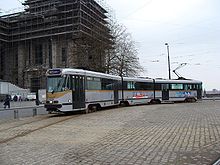
- PCC articulated car 7900: The PCC railcars of the 7900 series are outwardly similar to those of the 7700–7800 series, but there are also differences with regard to the later year of construction. Most noticeable is the middle section, which makes this car much longer. They also have a greater propulsion power and the interiors are different, which most passengers consider more comfortable. The disadvantage of this design is the lack of doors in the middle section, which slows down the change of passengers at busy stops, and above all the classic drive control, which comes close to the performance of two coupled PCC railcars. The conversion to an energy-saving chopper control was considered, but not carried out. This type was produced in 1977 and 1978. A total of 61 cars were produced, which, like the GTL8 in The Hague, are powered on all eight axles. These cars are mainly used on routes 19, 32, 55 and 82, and can also be seen regularly on routes 56 and 81.
- Low-floor car 2000: The first (and for a long time only) low-floor multiple unit of the STIB / MIVB were built in the 1990s. Although these vehicles also have some negative characteristics (for example, they are quite noisy), they represent a major innovation compared to the older PCC vehicles, mainly due to their accessibility . A total of 51 cars were built between 1993 and 1995. In the past they were used on lines 91, 92, 93 and 94. Since the line network reform in 2007, they currently only run on lines 24 and 94. Originally, they were also intended to be used on line 25, but due to technical problems they (perhaps definitely) decided not to.

- Low-floor cars 3000–4000 : The new generation of low-floor cars (type Flexity Outlook Cityrunner ) have been built since 2005. These vehicles have only been running on the Brussels tram network since 2006 and are intended to help solve the capacity problems on many tram lines. The T3000 consist of five car bodies and are only slightly longer than those of the older PCC type 7900. The T4000s are even longer with seven car bodies, but otherwise largely identical to the T3000. The T3000s are used on lines 4, 24, 25 and sometimes 23, the T4000s are currently only to be found on lines 3 and 23. 30 new trams will be delivered between 2020 and 2023.
These last tram types were delivered in the new corporate colors of the STIB / MIVB, for trams the silver gray metallic with black and gold colored stripes. These colors replace the old yellow-blue that all trams and city buses have been painted in since the 1990s. The remaining cars (with the exception of the old PCC cars of the 7000 series and part of the PCC 7700/7800) are to be repainted gradually.
In 2012, a restaurant tram was introduced under the name Tram Experience , which completes a tour while guests are served a two-star dinner. An old articulated trolley is used for this.
Trivia
- A trolley line 44 was during the RTBF - TV program about the independence of Flanders stopped on the language border on December 13 of 2006.
- The European tram championship took place in Brussels on May 4, 2019. The home team prevailed.
Web links
- Official website of the operator STIB / MIVB
- Brussels Tram Museum , English version
- Brussels tram (with map ) on UrbanRail.Net
See also
Individual evidence
- ^ Travel guides that published "Les Tramways Bruxellois" for the 1935 World's Fair.
- ↑ Inauguration du tram 9 à Bruxelles: "Un exemple pour l'avenir" , Sudinfo, September 1, 2018, 16:33 [1]
- ↑ [2]
- ↑ Bruzz: Brusselse regering keurt twee nieuwe tramlijnen goed , December 21, 2018, [3] , accessed on December 25, 2018, 5:35 pm
- ↑ Tim Gatz: Alles wat je moet weten over de twee nieuwe tramlijnen. Bruzz, December 21, 2018 [4] , accessed December 25, 2018 at 5:45 pm
- ↑ Trams 7000 out of service (Dutch)
- ↑ Brussels orders more New Generation Trams from Bombardier. In: railjournal.com. May 26, 2019, accessed July 11, 2019 .
- ↑ AD reiswereld, Page 7 March 24, 2012


